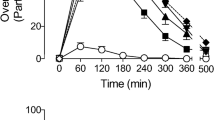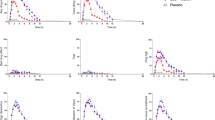Abstract
Rationale
Trifluoromethylphenyl piperazine (TFMPP) is an active constituent of a relatively new group of recreational drugs known as ‘party pills’. TFMPP has been anecdotally reported to induce mild psychedelic effects similar to lysergic acid diethylamide and psilocybin. There has been no research about the subjective effects of TFMPP in humans.
Objectives
This study aimed to investigate the subjective effects of TFMPP in human males.
Methods
A randomised, double-blind, placebo-controlled trial design was used to investigate the subjective effects of TFMPP in 30 healthy, non-smoking male volunteers (mean age 24 ± 4 years). Participants were randomised into two groups and given either TFMPP 60 mg (n = 15) or placebo (n = 15). Each participant completed three rating scales, the Addiction Research Centre Inventory (ARCI), the Profile of Mood States (POMS) and the Visual Analogue Scales (VAS), both before and 120 min after drug administration.
Results
Results from the ARCI indicated that TFMPP produced increases in ‘dysphoria’ and ‘dexamphetamine-like effects’. TFMPP also increased ratings of ‘tension/anxiety’ and ‘confusion/bewilderment’ as rated on the POMS. Results from the VAS indicated increases in ‘drug liking’, ‘high’ and ‘stimulated’ ratings relevant to placebo.
Conclusions
Increased ratings of ‘dexamphetamine-like effects’, ‘tension/anxiety’, ‘stimulated’ and ‘high’ following TFMPP administration resemble the subjective effects of common amphetamine-type stimulants. However, increases in ‘dysphoria’ and ‘confusion/bewilderment’ ratings following TFMPP are more commonly associated with drugs that have greater effects on serotonin release, binding and reuptake such as 1-[3-chlorophenyl]-piperazine, fenfluramine and lysergic acid diethylamide.



Similar content being viewed by others
References
Antia U, Tingle MD, Russell BR (2009) Metabolic interactions with piperazine-based ‘party pill’ drugs. J Pharm Pharmacol 61:877–882
Antia U, Tingle MD, Russell BR (2010) Validation of an LC–MS method for the detection and quantification of BZP and TFMPP and their hydroxylated metabolites in human plasma and its application to the pharmacokinetic study of TFMPP in humans. J Forensic Sci (in press)
Auerbach SB, Kamalakannan N, Rutter JJ (1990) TFMPP and RU24969 enhance serotonin release from rat hippocampus. Eur J Pharmacol 190:51–57
Auerbach SB, Rutter JJ, Juliano PJ (1991) Substituted piperazine and indole compounds increase extracellular serotonin in rat diencephalon as determined by in vivo microdialysis. Neuropharmacology 30:307–311
Baumann MH, Mash DC, Staley JK (1995) The serotonin agonist m-chlorophenylpiperazine (mCPP) binds to serotonin transporter sites in human brain. Neuroreport 6:2150–2152
Baumann MH, Clark RD, Budzynski AG, Partilla JS, Blough BE, Rothman RB (2005) N-substituted piperazines abused by humans mimic the molecular mechanism of 3,4-methylenedioxymethamphetamine (MDMA, or ‘ecstasy’). Neuropsychopharmacology 30:550–560
Cloëz-Tayarani I, Harel-Dupas C, Fillion G (1992) Inhibition of [3H] gamma-aminobutyric acid release from guinea-pig hippocampal synaptosomes by serotonergic agents. Fundam Clin Pharmacol 6:333–341
Conn PJ, Sanders-Bush E (1987) Relative efficacies of piperazines at the phosphoinositide hydrolysis-linked serotonergic (5-HT-2 and 5-HT-1C) receptors. J Pharmacol Exp Ther 242:652–657
Cunningham KA, Carroll BA, Appel JB (1986) Effects of repeated administration of the monoamine oxidase inhibitor phenelzine on the discriminability of d-lysergic acid diethylamide (LSD) and 1-(m-trifluoromethylphenyl) piperazine (TFMPP). Psychopharmacology 89:134–135
Deneau G, Yanagita T, Seevers MH (1969) Self-administration of psychoactive substances by the monkey. Psychopharmacologia 16:30–48
Erowid Piperazine Vault (2009) Erowid experience vaults: piperazine reports. http://www.erowid.org/chemicals/piperazines
Evans SN (2007) The role of estradiol and progesterone in modulating the subjective effects of stimulants in humans. Exp Clin Psychopharmacol 15:418–426
Fantegrossi WE, Winger G, Woods JH, Woolverton WL, Coop A (2005) Reinforcing and discriminative stimulus effects of 1-benzylpiperazine and trifluoromethylphenylpiperazine in rhesus monkeys. Drug Alcohol Depend 77:161–168
Fantegrossi WE, Murnane KS, Reissig CJ (2008) The behavioral pharmacology of hallucinogens. Biochemical Pharmacology 75:17–33
FDA (1997) US Food and Drug Administration postmarket drug safety information for patients and providers: FDA announces withdrawal of fenfluramine and dexfenfluramine. http://www.fda.gov/Drugs/DrugSafety/PostmarketDrugSafetyInformationforPatientsandProviders/ucm179871.htm
FDA (2009) US Food and Drug Administration. http://www.fda.gov
Folstein MF, Luria R (1973) Reliability, validity, and clinical application of the Visual Analogue Mood Scale. Psychol Med 3:479–486
Foltin RW, Fischman MW (1991) Assessment of abuse liability of stimulant drugs in humans: a methodological survey. Drug Alcohol Depend 28:3–48
Garattini S, Borroni E, Mennini T, Samanin R (1978) Differences and similarities among anorectic agents. In: Garattini S, Samanin R (eds) Central mechanisms of anorectic drugs. Raven, New York, pp 127–143
Griffith JD, Nutt JG, Jasinski DR (1975) A comparison of fenfluramine and amphetamine in man. Clin Pharmacol Ther 18:563–570
Grotewiel MS, Chu H, Sanders-Bush E (1994) m-Chlorophenylpiperazine and m-trifluoromethylphenylpiperazine are partial agonists at cloned 5-HT2A receptors expressed in fibroblasts. J Pharmacol Exp Ther 271:1122–1126
Haertzen CA, Hill HE, Belleville RE (1963) Development of the Addiction Research Center Inventory (ARCI): selection of items that are sensitive to the effects of various drugs. Psychopharmacologia 4:155–166
Hamik A, Peroutka SJ (1989) 1-(m-Chlorophenyl)piperazine (mCPP) interactions with neurotransmitter receptors in the human brain. Biol Psychiatry 25:569–575
Herndon L, Pierson ME, Glennon RA (1992) Mechanistic investigation of the stimulus properties of 1-(3-trifluoromethylphenyl) piperazine. Pharmacol Biochem Behav 43:739–748
Kahn RS, Wetzler S (1991) m-Chlorophenylpiperazine as a probe of serotonin function. Biol Psychiatry 30:1139–1166
Kennett GA, Curzon G (1988) Evidence that hypophagia induced by mCPP and TFMPP requires 5-HT1C and 5-HT1B receptors; hypophagia induced by RU 24969 only requires 5-HT1B receptors. Psychopharmacology 96:93–100
Koob GF (1992) Neuronal mechanisms of drug reinforcement. Ann N Y Acad Sci 654:171–191
Lin JC, Bangs N, Lee HS, Kydd RR, Russell BR (2009) Determining the subjective and physiological effects of BZP on human females. Psychopharmacology 207:439–446
Martin WR, Sloan JW, Sapira JD, Jasinski DR (1971) Physiologic, subjective, and behavioral effects of amphetamine, methamphetamine, ephedrine, phenmetrazine, and methylphenidate in man. Clin Pharmacol Ther 12:245–258
McKenney JD, Glennon RA (1986) TFMPP may produce its stimulus effects via a 5-HT1B mechanism. Pharmacol Biochem Behav 24:43–47
McNair DM, Heuchert JWP, Shilony E (2003) Research with the Profile of Mood States (POMS) 1964–2002: a comprehensive bibliography. MHC, Toronto, pp 7–8
Miranda F, Orozco G, Velazquez-Martinez DN (2002) Full substitution of the discriminative cue of a 5-HT(1A/1B/2C) agonist with the combined administration of a 5-HT(1B/2C) and a 5-HT(1A) agonist. Behav Pharmacol 13:303–311
Misuse of Drugs Amendment Act (2008) Classification of BZP Amendment Bill: Bill 146-2, New Zealand
Robertson DW, Bloomquist W, Wong DT, Cohen ML (1992) mCPP but not TFMPP is an antagonist at cardiac 5HT3 receptors. Life Sci 50:599–605
Rothman RB, Ayestas MA, Dersch CM, Baumann MH (1999) Aminorex, fenfluramine, and chlorphentermine are serotonin transporter substrates. Implications for primary pulmonary hypertension. Circulation 100:869–875
Rothman RB, Baumann MH, Dersch CM, Romero DV, Rice KC, Carroll FI, Partilla JS (2001) Amphetamine-type central nervous system stimulants release norepinephrine more potently than they release dopamine and serotonin. Synapse 39:32–41
Schechter MD (1988) Use of TFMPP stimulus properties as a model of 5-HT1B receptor activation. Pharmacol Biochem Behav 31:53–57
Schoeffter P, Hoyer D (1989) Interaction of arylpiperazines with 5-HT1A, 5-HT1B, 5-HT1C and 5-HT1D receptors: do discriminatory 5-HT1B receptor ligands exist? Naunyn Schmiedebergs Arch Pharmacol 339:675–683
Sheridan J, Butler R (2007) Legal party pills and their use by young people in New Zealand: a qualitative study. Final report of findings (revised June 2007). University of Auckland, Auckland
Sheridan J, Butler R, Wilkins C, Russell B (2007) Legal piperazine-containing party pills—a new trend in substance misuse. Drug Alcohol Rev 26:335–343
Tancer M, Johanson C-E (2003) Reinforcing, subjective, and physiological effects of MDMA in humans: a comparison with d-amphetamine and mCPP. Drug Alcohol Depend 72:33–44
The UK Home Office (2009) Control of ‘legal highs’ including GBL, BZP, synthetic cannabinoids and others. http://drugs.homeoffice.gov.uk/news-events/latest-news/control-of-legal-highs-dec09.html
US Drug Enforcement Administration, Department of Justice (2002) Schedules of controlled substances: temporary placement of benzylpiperazine and trifluoromethylphenylpiperazine into Schedule I. Fed Regist 67:59161–59162
Wilkins C, Girling M, Sweetsur P, Huckle T, Huakau J (2006) Legal party pill use in New Zealand: prevalence of use, availability, health harms and ‘gateway effects’ of benzylpiperazine (BZP) and triflourophenylmethylpiperazine (TFMPP). Centre for Social and Health Outcomes Research and Evaluation, Massey University, Auckland
Zacny JP, de Wit H (1989) Effects of food deprivation on subjective responses to d-amphetamine in humans. Pharmacol Biochem Behav 34:791–795
Acknowledgements
This study was sponsored by the Health Research Council of New Zealand. The authors would like to acknowledge Dr. John Sollers and Associate Professor Nathan Consedine for their statistical advice. The authors have no conflict of interest to declare.
Author information
Authors and Affiliations
Corresponding author
Rights and permissions
About this article
Cite this article
Jan, R.K., Lin, J.C., Lee, H. et al. Determining the subjective effects of TFMPP in human males. Psychopharmacology 211, 347–353 (2010). https://doi.org/10.1007/s00213-010-1911-y
Received:
Accepted:
Published:
Issue Date:
DOI: https://doi.org/10.1007/s00213-010-1911-y




